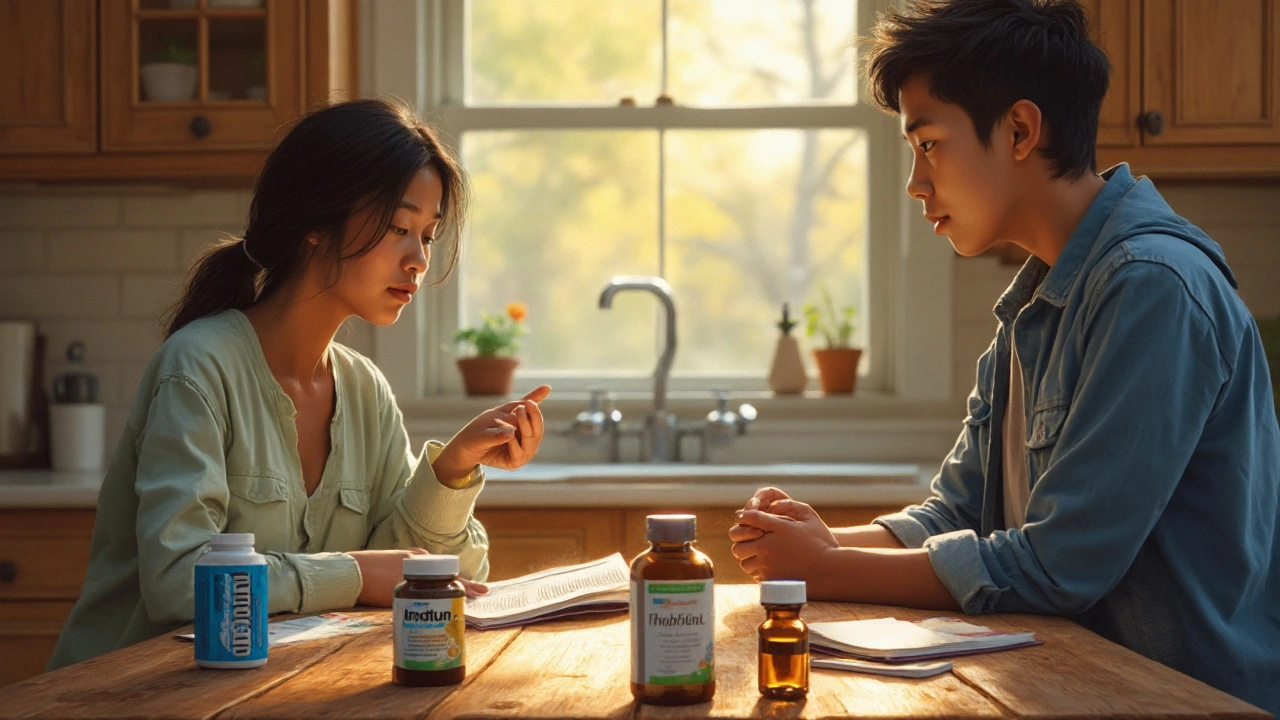Diarrhea Treatment Selector
1. Do you have fever or blood in the stool?
2. Is there a risk of dehydration (vomiting, young child, elderly, or excessive fluid loss)?
3. Do you have a prescription available for stronger medication?
4. Would you prefer a natural, non‑drug approach?
5. Do you need fast relief for mild, non‑bloody diarrhea?
Quick Takeaways
- Imodium (loperamide) slows gut movement and is great for mild‑to‑moderate acute diarrhea.
- Pepto‑Bismol (bismuth subsalicylate) adds an antimicrobial edge for infections.
- Lomotil (diphenoxylate/atropine) is stronger but requires a prescription.
- Probiotics such as Saccharomyces boulardii a live yeast that restores gut flora work best for antibiotic‑associated or travel‑related leaks.
- Oral Rehydration Solution (ORS) isn’t a stop‑gap for stool frequency but saves lives by preventing dehydration.
Imodium is a synthetic opioid (loperamide) that reduces intestinal motility, approved by the Food and Drug Administration for over‑the‑counter use. It works by binding to µ‑opioid receptors in the gut wall, slowing peristalsis and allowing more water to be reabsorbed. The usual adult dose is 2mg after the first loose stool, followed by 2mg after each subsequent stool, not exceeding 8mg per day for OTC use.
When Imodium Is the Right Choice
Imodium shines when you need rapid relief without a bacterial cause-think “run‑of‑the‑mill” food‑borne upset or stress‑related loose stools. The World Health Organization recommends it for acute, non‑bloody diarrhea in adults who are not severely dehydrated. However, it’s a bad idea if you have high fever, blood in stool, or signs of a serious infection; slowing the gut can trap toxins.
Key Alternatives and How They Differ
Below are the most common stand‑ins, each with its own mechanism and ideal scenario.
Pepto‑Bismol is bismuth subsalicylate, an antisecretory and mild antibacterial agent. It coats the lining, kills some bacteria (like Helicobacter pylori), and reduces inflammation. Dose: 525mg every 30‑60minutes, up to 8 doses per day. Best for traveler's diarrhea, especially when fever or mild abdominal cramps accompany the stool.
Lomotil combines diphenoxylate (a stronger opioid) with atropine to deter abuse. Prescription‑only in most countries. Starts at 2.5mg diphenoxylate/0.025mg atropine, titrated up to 5mg/0.05mg. Use only when over‑the‑counter options fail or for chronic diarrhea due to inflammatory bowel disease.
Probiotics such as Saccharomyces boulardii or Lactobacillus rhamnosus GG replenish beneficial microbes. A typical dose is 10-20billion CFU daily for 5‑7days. Ideal for antibiotic‑associated diarrhea and for patients who prefer a non‑drug approach.
Oral Rehydration Solution (a precise mix of glucose, sodium, potassium, and citrate) doesn’t stop stool frequency but prevents dangerous fluid loss. WHO formula: 2.6g NaCl, 1.5g KCl, 2.9g trisodium citrate, 13.5g glucose per litre of clean water. Use whenever dehydration risk is high, regardless of the anti‑diarrheal chosen.
Side‑by‑Side Comparison
| Agent | Mechanism | Typical Dose | Prescription? | Best Use Case |
|---|---|---|---|---|
| Imodium | µ‑opioid receptor agonist → slows motility | 2mg after first loose stool, max 8mg/day | No | Acute, non‑bloody diarrhea |
| Pepto‑Bismol | Antisecretory + antimicrobial | 525mg q30‑60min, max 8 doses | No | Travelers, mild fever, abdominal cramping |
| Lomotil | Strong opioid + atropine | 2.5mg/0.025mg BID, up to 5mg/0.05mg | Yes | Severe or chronic diarrhea not responding to OTC |
| Probiotics | Microbial balance restoration | 10-20billion CFU daily | No | Antibiotic‑associated, IBS‑related |
| ORS | Electrolyte‑glucose absorption | 1‑2L per day, as needed | No | Any diarrheal episode with dehydration risk |

How to Pick the Right Option
Start with the "severity‑and‑cause" matrix:
- Cause known? If you suspect bacterial infection (fever, blood), lean toward Pepto‑Bismol or antibiotics, not Imodium.
- Dehydration risk? If you’re vomiting, have kids, or are elderly, add ORS before any anti‑motility drug.
- Prescription freedom? If you have a doctor’s note, Lomotil provides a stronger punch; otherwise stick with OTC.
- Preference for natural? Probiotics are safe for most, but they take longer to show effect.
When in doubt, combine a low‑dose Imodium (2mg) with ORS to keep fluids moving while the stool frequency drops.
Safety Tips & Common Interactions
Imodium can interact with CYP3A4 inhibitors (e.g., erythromycin, ketoconazole) leading to higher plasma levels and rare cardiac events. Avoid mixing with other opioids or antidiarrheals to prevent excessive gut slowdown.
Pepto‑Bismol contains salicylate-don’t use if you’re allergic to aspirin or if you’re on anticoagulants. Lomotil’s atropine component may cause dry mouth, blurred vision, or tachycardia; watch out if you have glaucoma.
Probiotics are generally safe, but patients with severely weakened immune systems should consult a clinician first.
Related Concepts Worth Knowing
Understanding the broader picture helps you treat the root cause, not just the symptom.
- Rehydration strategies: Beyond ORS, consider coconut water or clear broths if ORS isn’t palatable.
- Dietary tweaks: The BRAT diet (bananas, rice, applesauce, toast) can give the gut a gentle break.
- Travel preparedness: Pack Imodium, Pepto‑Bismol, and ORS packets-most airlines allow them in carry‑on.
- Antibiotic‑associated diarrhea: Stop the offending antibiotic if possible, start a probiotic, and keep hydrated.
- Chronic conditions: For inflammatory bowel disease, talk to a gastroenterologist about lomotil or prescription‑grade loperamide.
Bottom Line
If you need fast relief for a run‑of‑the‑mill upset, Imodium remains the go‑to OTC choice. But when infection signs appear, when you’re caring for a child, or when you have a prescription on hand, alternatives like Pepto‑Bismol, Lomotil, or probiotics may be safer or more effective. Always pair any anti‑diarrheal with proper rehydration.
Frequently Asked Questions
Can I give Imodium to my child?
For children under 6years, most health agencies advise against loperamide because their nervous systems process the drug differently. For ages 6‑12, a pediatrician may recommend a half‑strength dose (1mg) after the first loose stool, but only if there’s no fever or blood.
Is it safe to combine Imodium with oral rehydration solution?
Yes. ORS replaces lost electrolytes while Imodium reduces stool frequency. In fact, the WHO recommends using both together for most acute diarrheal episodes in adults.
What should I do if I experience severe constipation after taking Imodium?
Stop the medication immediately and increase fluid intake. If you can’t pass stool for more than 48hours, seek medical help; the pharmacist may suggest a gentle laxative or a short course of an osmotic agent.
Does Pepto‑Bismol work for viral gastroenteritis?
It can relieve symptoms like nausea and cramping, but it doesn’t target the virus itself. For viral causes, focus on hydration and let the infection run its course.
Are probiotics effective for acute diarrhea?
Evidence shows certain strains (e.g., Saccharomyces boulardii) cut the duration of acute infectious diarrhea by about a day. They’re most useful when antibiotics have disrupted the gut flora.
Can I use Lomotil if I’m already taking Imodium?
Mixing two opioid‑based antidiarrheals can cause dangerously slow gut transit and constipation. Only one should be used at a time, and under doctor's guidance.

